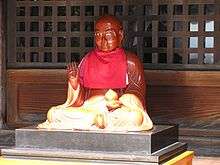Pindola Bharadvaja
| Venerable Pindola | |
|---|---|
 Pindola (Binzuru) statue in Mitsu-tera Temple, Osaka, Japan | |
| Other names | Pindola Bharadvaja |
| Religious career | |
| Teacher | Buddha |
According to the earliest Indian sutra's Pindola Bharadvaja was one of four Arhats asked by the Buddha to remain in the world to propagate Buddhist law (Dharma). Each of the four was associated with one of the four compass directions.
Pindola is said to have excelled in the mastery of occult and psychic powers. He was once remonstrated by Buddha for misusing his powers to impress simple, ignorant people.[1]
Along with Ananda, Pindola preached to the women of Udena's palace at Kosambi on two different occasions.[2]
In later centuries, the number of Arhats increases from four to Sixteen Arhats, then later on to 18. In Tibetan Thangka paintings depicting the 18 Arhats, Pindola Bharadvaja is usually depicted holding a book and begging bowl.
Born into a family of royal chaplains, Pindola Bharadvaja became a monk because he found no meaning in his life.[3] Although he was greedy first, this changed as he began obeying Buddha and working to help others.[4] Pindola Bharadvaja is often depicted with a scripture in his right hand and an alms bowl in his left hand, symbolizing his aid and protection over the suffering in the lower realms.[5] Pindola Bharadvaja lives with 1,000 arhats on the eastern continent (Purvavideha) in a mountain cave.[6]
In Japan
In Japan, Pindola is called Binzuru (賓頭盧), a short form of Bindora Baradaja (賓度羅跋囉惰闍), and is arguably the most popular of all the Arhats. The monastery refectory near Tōdai-ji Temple at Nara has a large wooden statue of Binzuru, depicting him seated in the lotus position. Statues of him are usually well worn, since the faithful follow the custom of rubbing a part of the effigy corresponding to the sick parts of their bodies, as he is reputed to have the gift of healing. Nagano, whose Zenkoji temple also hosts a well-worn Binzuru statue, stages a yearly Binzuru festival.
He is also very frequently offered red and white bibs and children's caps to watch over the health of babies, so that his statue is often decked in rags. He is represented in painting as an old man seated on a rock, holding in his hand a sort of sceptre (a Japanese shaku), or a sutra box and a feather fan. All the other Arahants are usually worshipped in Japan in his person.[7]
Notes
| Wikimedia Commons has media related to Pindola Bharadvaja. |
- ↑ "The Buddha's Attitude to Miracles". Life of Buddha. www.buddhanet.net. Retrieved 2008-06-27.
- ↑ Vin.ii.290f; SNA.ii.514; J.iv.375
- ↑ "Pindola Bharadvaja - Rigpa Wiki". www.rigpawiki.org. Retrieved 2016-03-03.
- ↑ "Pindola Bharadvaja - Rigpa Wiki". www.rigpawiki.org. Retrieved 2016-03-03.
- ↑ "Pindola Bharadvaja - Rigpa Wiki". www.rigpawiki.org. Retrieved 2016-03-03.
- ↑ "Pindola Bharadvaja - Rigpa Wiki". www.rigpawiki.org. Retrieved 2016-03-03.
- ↑ "Pindola - Bindora Baradaja". rakan-arhat-lohan. onmarkproductions. Retrieved 2008-06-27.
